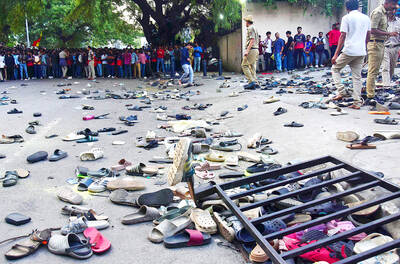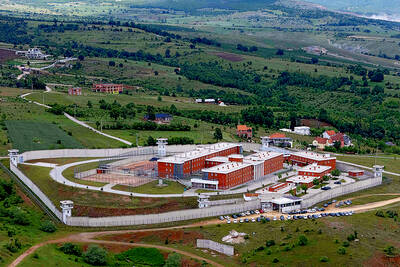“Here all animals are born and live free until they die,” Victorino Martin said, pointing proudly to the herds of fighting bulls grazing by the Tagus River on a famous breeding farm in Spain.
With their trademark gray coat, the bulls weigh about half a tonne when they reach maturity at five years old. By then, some of them will already have been sent to their death in bullfighting arenas, a tradition cherished and reviled in Spain.
However, for Martin, a veterinarian, breeding bulls is a passionate, family affair and he stresses his cattle are treated with more dignity and humanity than those destined for people’s plates.
On the Las Tiesas de Santa Maria ranch in the southwestern Extremadura region, the bulls munch peacefully in a field scattered with spring flowers.
However, it is a deceptive calm.
“They fight and kill each other,” the 56-year-old second-generation breeder said with a warm slim.
“There are nearly as many deaths in breeding farms as in the arena,” he added.
The keepers on horseback stay well away. Several sport the scars of horn butts.
The ranch, with its 1,100 animals spread over about 2,000 hectares, is famous among bullfighting fans.
“Victorino Martin, the father, created this farm from nothing and turned it into a legend,” said Juan Diego Madueno, a journalist who specializes in bullfighting.
He bought a herd in 1960 and quickly bettered the breed to make his bulls stronger.
“Before, people would go to the arenas to see the toreros [bullfighters]. With Victorino Martin, they ended up going to see the bulls,” Madueno said.
“He allowed breeders to ask for payment for participating in corridas [bullfights],” he said.
Martin junior has inherited his father’s passion.
“My first memory was going to feed the bulls with him, when I was four,” he said.
Just like his father, he is a novillero, a bullfighter who fights two or three-year-old bulls.
He carefully selects breeding pairs, and the resulting young bulls and cows are tested on the ranch as if they were in a bullfighting arena.
Those who show the most fighting spirit are destined for reproduction, and their calves will grow up and become toros bravos — those who go to the arena.
The others will be sent to the abattoir.
Martin is head of the Fighting Bull Foundation, created by breeders in 2015 to defend bullfighting in Spain. That year, about 300 left-wing municipalities banned shows involving bulls, foundation director-general Borja Cardelus said.
For Martin, the corrida is “a sacrificial ritual where man must risk his life in order to be allowed to kill the animal.”
He also defends the becerradas, bullfights for beginners with calves that can be particularly gruesome and have been slammed by animal rights activists.
“They’re necessary for the training of young toreros,” he said.
However they are becoming “fewer and fewer,” said his daughter, Pilar, 32, also a veterinarian and passionate about bullfighting.
Martin points to the free-range life of his animals, of which only 10 percent are sent to fight every year, compared with cattle in the food industry, which are often locked up and killed when they are “10 to 15 months” old.
“A breeding farm for fighting bulls is one of few places where a cow can die of old age — up to 22 years — while a dairy cow is killed after her fourth lactation,” he said.
A bull, meanwhile, can live until it is 14 years old.
Cobradiezmos may well reach that age. The muscular bull was pardoned for bravery in combat on April 13, 2016, in Sevilla by bullfighter Manuel Escribano.
Since then, he has grazed a wide stretch of land peppered with oak trees, surrounded by 35 cows that have given him seven calves.
Of the 20,000 bulls killed last year, a mere 29 were pardoned, the foundation said.
However, this ritual underscores the respect that bullfighting fans have for the bull.
“The fan soaks in the bull’s qualities,” Martin said.
“He doesn’t complain, rises above hardship and fights until the end,” he added.

Packed crowds in India celebrating their cricket team’s victory ended in a deadly stampede on Wednesday, with 11 mainly young fans crushed to death, the local state’s chief minister said. Joyous cricket fans had come out to celebrate and welcome home their heroes, Royal Challengers Bengaluru, after they beat Punjab Kings in a roller-coaster Indian Premier League (IPL) cricket final on Tuesday night. However, the euphoria of the vast crowds in the southern tech city of Bengaluru ended in disaster, with Indian Prime Minister Narendra calling it “absolutely heartrending.” Karnataka Chief Minister Siddaramaiah said most of the deceased are young, with 11 dead

By 2027, Denmark would relocate its foreign convicts to a prison in Kosovo under a 200-million-euro (US$228.6 million) agreement that has raised concerns among non-governmental organizations (NGOs) and residents, but which could serve as a model for the rest of the EU. The agreement, reached in 2022 and ratified by Kosovar lawmakers last year, provides for the reception of up to 300 foreign prisoners sentenced in Denmark. They must not have been convicted of terrorism or war crimes, or have a mental condition or terminal disease. Once their sentence is completed in Kosovan, they would be deported to their home country. In

DENIAL: Musk said that the ‘New York Times was lying their ass off,’ after it reported he used so much drugs that he developed bladder problems Elon Musk on Saturday denied a report that he used ketamine and other drugs extensively last year on the US presidential campaign trail. The New York Times on Friday reported that the billionaire adviser to US President Donald Trump used so much ketamine, a powerful anesthetic, that he developed bladder problems. The newspaper said the world’s richest person also took ecstasy and mushrooms, and traveled with a pill box last year, adding that it was not known whether Musk also took drugs while heading the so-called US Department of Government Efficiency (DOGE) after Trump took power in January. In a

LOST CONTACT: The mission carried payloads from Japan, the US and Taiwan’s National Central University, including a deep space radiation probe, ispace said Japanese company ispace said its uncrewed moon lander likely crashed onto the moon’s surface during its lunar touchdown attempt yesterday, marking another failure two years after its unsuccessful inaugural mission. Tokyo-based ispace had hoped to join US firms Intuitive Machines and Firefly Aerospace as companies that have accomplished commercial landings amid a global race for the moon, which includes state-run missions from China and India. A successful mission would have made ispace the first company outside the US to achieve a moon landing. Resilience, ispace’s second lunar lander, could not decelerate fast enough as it approached the moon, and the company has